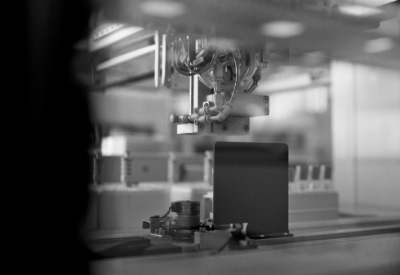Exploring Lithium Power in a Portable World
In a world increasingly dependent on portable electronic devices, batteries play a pivotal role in powering our everyday lives. While City Labs’ NanoTritium™ batteries have gained prominence for their groundbreaking tritium-based nuclear technology and variety of applications, it’s important to understand other key players in the battery world.
Learning the basics of lithium batteries, how they differ from traditional batteries, and their role in modern technology will help explain why these batteries are a major contender in the race for efficient and rechargeable power sources.
What Is a Lithium Battery?
Lithium batteries, specifically known as lithium-ion or Li-ion batteries, are a widely employed type of rechargeable battery that uses lithium to drive core electrochemical reactions. These batteries are distinct from traditional (i.e., disposable) batteries that can’t be safely recharged.
Lithium-ion batteries are designed to handle repeated charge/discharge cycles and boast an impressive energy density, lightweight design, and a relatively low self-discharge rate compared to many other battery alternatives. Combined, these qualities have made them a common choice for a wide range of technology used in our daily lives.
How Do Lithium-Ion Batteries Work?
Li-ion batteries operate via lithium ions moving back and forth between the positive and negative battery electrodes, which are commonly made of lithium iron phosphate, lithium manganese oxide, or lithium cobalt oxide. During the charging process, lithium ions move from the positive electrode (i.e., the cathode) to the negative electrode (i.e., the anode). During discharge, the ions travel back from the anode to the cathode. The ions’ repeated movement generates electrical energy that can power electronic devices.
Lithium-Ion Battery Applications
Lithium-ion batteries have become vital to modern technology, with some common applications including:
Portable Electronics
Lithium-ion batteries are frequently used in smartphones, laptops, tablets, and other portable devices, providing an efficient and sustained power source that can easily be recharged for daily use.
Electric Vehicles
The automotive industry has enthusiastically adopted lithium-ion batteries to power increasingly popular electric/hybrid vehicles, with continuing battery advances providing enhanced range and energy efficiency. A notable downside of electric vehicle Li-ion batteries is their sheer weight, requiring sacrifices in power capacity to keep the total vehicle weight reasonable.
Renewable Energy Storage
Lithium-ion batteries are often used to store energy harvested from renewable sources, such as solar panels and wind turbines, assuring a consistent and readily accessible supply of electricity.
Medical Devices
Many common external and implantable medical devices, including pacemakers, defibrillators, and insulin pumps, rely on lithium-ion batteries due to their relatively compact size and extended lifespan compared to most other battery alternatives.
Lithium-Ion Battery Life
The average life of lithium-ion batteries varies depending on factors that include usage patterns, environmental conditions, battery size, etc. As a general principle, however, these batteries typically last between 2 to 10 years due to the degradation associated with normal use.
Key factors influencing this battery lifespan include:
Charge and Discharge Cycles
Repeated cycles of charging and discharging that come with normal device use can gradually shorten a lithium-ion battery’s lifespan and performance.
Extreme Temperatures
Temperatures at either extreme can cause a range of performance issues that lead to drastically shortened lifespans or catastrophic failure for lithium-ion batteries.
Depth of Discharge
The depth of discharge for a lithium-ion battery refers to the percentage of the battery’s total capacity that is discharged or used. In other words, it represents how much of the battery’s energy is consumed relative to its full capacity. Frequent deep discharges greatly hasten Li-ion battery deterioration.
Quality and Maintenance
Battery quality and consistent maintenance practices are pivotal in determining how long a battery remains serviceable. As Lithium-ion batteries are mass-produced on a global scale, variations in production quality yield noticeable performance differences.
Advantages of Lithium-Ion Batteries
Lithium-ion batteries boast several notable advantages over traditional batteries, including:
High Energy Density
Lithium-ion batteries offer impressive energy density, meaning they can store a vast amount of energy in a relatively small and lightweight package. This makes them perfect for portable electronic devices like cell phones and laptops, where size and weight matter.
Rechargeability
Unlike disposable batteries, lithium-ion batteries are built to be recharged; reusable batteries deliver environmental benefits, cost savings, and user convenience.
Low Self-Discharge Rate
Compared to traditional batteries, lithium-ion batteries offer a much lower self-discharge rate, meaning they can retain their charge for extended periods of time when not in use. This allows devices that see infrequent use to retain important functions and minimizes the risk of catastrophic battery failure that causes acid leakage, which can damage the connected device.
No Memory Effect
Lithium-ion batteries are generally not prone to memory effects, a phenomenon where batteries lose capacity if not fully discharged before recharging. Users can recharge lithium-ion batteries at any time without worrying about substantially harming their capacity.
Versatile Applications
Lithium-ion batteries can be used to power a diverse range of applications, including consumer electronics, electric vehicles, renewable energy storage, and beyond. Their versatility has spurred extensive research and development efforts, driving continuous improvements.
Fast Charging
Increasingly, lithium-ion batteries incorporate fast or adaptive charging, whereby the recharge rate can be adjusted dynamically based on the battery’s state, allowing important devices like cell phones to be recharged quickly.
Disadvantages of Lithium-Ion Batteries
Despite the many advantages of lithium-ion batteries, they also have a few notable drawbacks:

Limited Lifespan
Lithium-ion batteries degrade over time, with the average Li-ion battery expected to last for approximately 300 to 500 charge-discharge cycles. Typically, this means lithium-ion batteries will fail sometime within a 2- to 10-year period, depending on factors like usage patterns and environmental factors that make capacity wane over time, necessitating replacement.
Sensitivity to Temperature
Extreme temperatures can adversely affect a lithium-ion battery’s performance and lifespan, so these batteries are ill-suited for use in extremely hot or cold environments without relying on external temperature-control devices, such as warming boxes. Low temperatures can slow the electrochemical reactions within the batteries—drastically reducing power output—and high temperatures can trigger overheating, which lithium-ion batteries are already prone to, as well as thermal runaway.
Environmental Concerns
The production and disposal of lithium-ion batteries lead to environmental concerns due to the extraction of lithium and other raw materials, which can adversely affect local ecosystems via air and soil contamination. Appropriate recycling and disposal practices can only partially mitigate these harmful effects.
Safety Concerns
Lithium-ion batteries are generally safe when used correctly; however, isolated incidents of battery fires and explosions periodically surface and are usually linked to manufacturing defects or misuse. It is crucial to ensure stringent safety measures are taken during the production of lithium-ion batteries and that consumers only use the batteries within specified operational parameters.
High Initial Cost
The manufacturing of lithium-ion batteries can carry a hefty price tag, which often trickles down to products employing them. This is especially notable in electric vehicles, which can rely on thousands of individual battery cells.
Capacity Fade
Over time, lithium-ion batteries experience capacity fade, a phenomenon where their capacity gradually diminishes with each charge and discharge cycle, resulting in reduced runtime for devices, often necessitating semi-frequent replacement.
The Future of Lithium-Ion Batteries
Despite some limitations, lithium-ion batteries continue to play a major role in society thanks to continuing research and development efforts aimed at bolstering their performance and safety. In addition to these incremental improvements, lithium-ion batteries are also finding novel applications, being increasingly integrated into grid energy storage systems, aiding renewable energy sources, and bolstering power grids. Furthermore, advancements in fast-charging technology address one of the key pain points associated with lithium-ion batteries.
While lithium-ion batteries may become increasingly adept at such use cases as time goes on, they will likely always be limited by the physical electrochemical reactions that produce their power. This means that lithium-ion batteries will likely never be ideal for applications that prioritize battery longevity or operational efficiency in extreme environments.
Comparing NanoTritium Batteries With Lithium-Ion Batteries
City Labs’ NanoTritium™ battery products are a unique type of nuclear battery, leveraging tritium and the principles of betavoltaic conversion to produce a low-power energy solution that stands as a compelling alternative to lithium-ion batteries, especially in specific contexts:
Extreme Temperatures
NanoTritium™ batteries can thrive in extreme temperatures ranging from -55°C to +150°C, making them ideal batteries for extremely hot applications as well as extremely cold situations where conventional and lithium-ion batteries would falter, such as outer space and underwater settings.
Radiation Resistance
NanoTritium™ batteries exhibit remarkable resilience in the face of radiation exposure, a crucial characteristic for powering electronic devices in space.
Longevity
NanoTritium™ batteries boast an incredible lifespan of 20+ years thanks to the slow decay of tritium, far surpassing the capabilities of lithium-ion batteries. This is especially useful for applications where battery replacement is undesirable, such as in communications security (COMSEC) devices, for medical implants, such as leadless pacemakers, or settings in space where batteries cannot be readily replaced.
Durability
In addition to the factors listed above, NanoTritium™ batteries are highly resistant to physical stressors, including vibration, salinity, and more. This means NanoTritium™ batteries can survive harsh launch conditions or be used in deep-sea settings without fear of failure.
Low-Power Electronics
NanoTritium™ batteries harness the natural decay of tritium to produce consistent but low amounts of power, making them perfect for powering electronic devices, sensors, and motes that require power at the microwatt, milliwatt, and nanowatt levels.
Conversely, lithium-ion batteries usually output power in the watt-to-kilowatt range, meaning they are typically not designed to output power at such low levels. Instead, they are more commonly used for higher-power applications, such as powering larger electronic devices, electric vehicles, and providing energy storage. The power output of a lithium-ion battery is typically in the watt-to-kilowatt range, depending on the specific battery and application.










